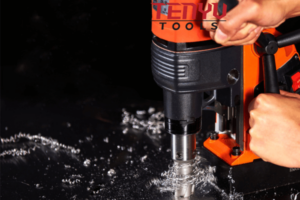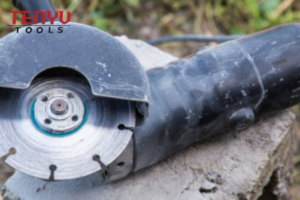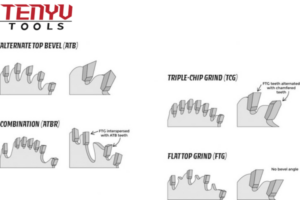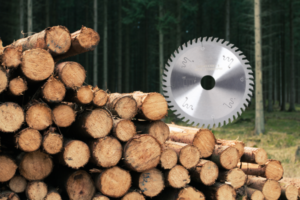Choosing the wrong multi-rip saw blade diameter can waste wood and money. Are you unsure how to pick the right size for your machine and cutting needs? Let me help you select the perfect blade.
The outer diameter of multi-rip saw blades generally ranges from 110mm up to 550mm. The best diameter depends primarily on your sawing machine’s installation limits and the thickness of the wood you need to cut.
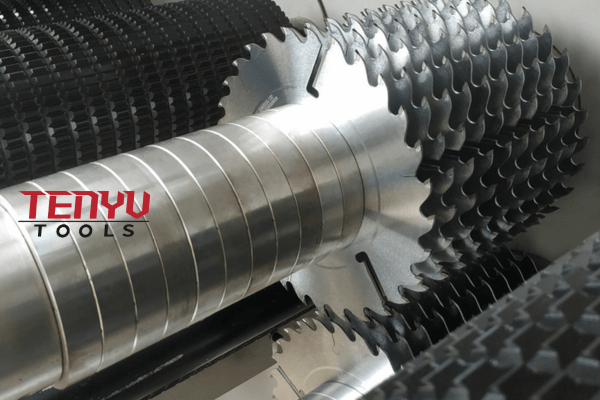
Selecting the right diameter is crucial for performance and efficiency in wood processing. Different machines and materials have different needs. Let’s explore the common sizes available and how you can make the best choice for your specific situation. As someone who deals with these blades daily at Tenyu, I know how important this decision is.
What Are the Common Multi-Rip Saw Blade Specifications?
Are you confused by the variety of multi-rip saw blade specifications on the market? Picking the wrong specs can lead to poor cuts or damage your equipment. Let’s clarify the common options.
Common multi-rip saw blades come in many specifications, with diameters ranging from 140mm to 455mm and beyond. Key specifications include diameter, blade thickness, kerf thickness, arbor size, and tooth count.
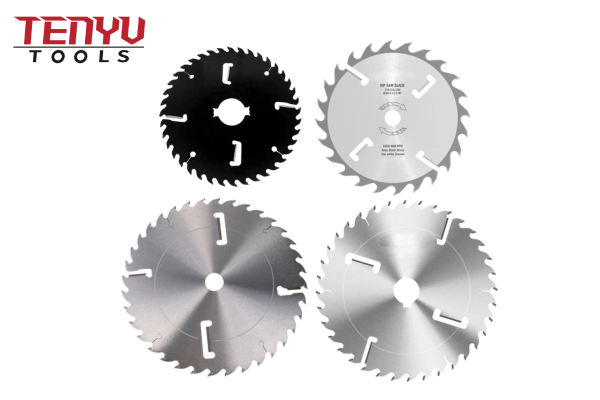
Understanding Multi-Rip Saw Blade Codes
Choosing the right blade involves looking beyond just the diameter. The specifications tell you a lot about the blade’s intended use1 and performance. Manufacturers often use codes to represent these details. Here are some examples commonly found in the market, similar to what we offer at Tenyu:
Table 1: Example Specifications (TJ Series)
| Blade Code | Diameter (MM) | Thickness (Blade/Kerf) (MM) | Arbor Size (MM) | Number of Teeth (T) |
|---|---|---|---|---|
| TJ001 | 140 | 1.0 / 0.7-1.4 | 25.4 | 60 |
| TJ002 | 160 | 1.0 / 0.7-1.4 | 25.4 | 40 |
| TJ003 | 160 | 1.0 / 0.8-1.4 | 25.4 | 60 |
| TJ004 | 180 | 1.2 / 0.8-1.4 | 25.4 | 40 |
| TJ005 | 180 | 1.2 / 0.9-1.4 | 25.4 | 60 |
| TJ006 | 230 | 1.2 / 0.9-1.4 | 25.4 | 50 |
| TJ007 | 230 | 1.2 / 0.9-1.4 | 25.4 | 40 |
| TJ008 | 230 | 1.2 / 0.9-1.4 | 25.4 | 48 |
| TJ009 | 255 | 1.4 / 1.0-1.8 | 25.4 | 48 |
Table 2: Example Specifications (KA Series – Inches Included)
| Blade Code | Diameter (Inch) | Diameter (MM) | Thickness (Blade/Kerf) (MM) | Arbor Size (MM) | Number of Teeth (T) |
|---|---|---|---|---|---|
| KA001 | 7 | 180 | 2.0 / 1.8 | 25.4 | 60 |
| KA002 | 7 | 180 | 2.0 / 2.0 | 25.4 | 60 |
| KA003 | 7 | 180 | 2.0 / 2.4 | 25.4 | 60 |
| KA004 | 8 | 205 | 2.0 | 25.4 | 100 |
| KA005 | 10 | 250 | 3.2 / 2.6 | 25.4 | 80 |
| KA006 | 10 | 255 | 3.0 / 2.4 | 25.4 | 100 |
| KA007 | 10 | 255 | 3.0 / 2.4 | 25.4 | 120 |
| KA008 | 12 | 305 | 3.0 / 2.8 | 25.4 | 80 |
| KA009 | 12 | 305 | 3.0 / 2.8 | 25.4 | 100 |
| KA010 | 12 | 305 | 3.0 / 2.8 | 25.4 | 120 |
| KA011 | 14 | 355 | 3.0 / 2.8 | 25.4 | 100 |
| KA012 | 14 | 355 | 3.0 / 2.8 | 25.4 | 120 |
| KA013 | 15 | 380 | 3.0 / 2.8 | 25.4 | 100 |
| KA014 | 15 | 380 | 3.0 / 2.8 | 25.4 | 120 |
| KA015 | 16 | 405 | 3.0 / 2.8 | 25.4 | 100 |
| KA016 | 16 | 405 | 3.0 / 2.8 | 25.4 | 120 |
| KA017 | 18 | 455 | 3.0 / 2.8 | 25.4 | 100 |
| KA018 | 18 | 455 | 3.0 / 2.8 | 25.4 | 120 |
These tables show the variety available. Remember, the exact specifications might vary between manufacturers. We at Tenyu can provide blades matching these specs or customize them for you.
How Do You Choose the Right Multi-Rip Saw Blade Diameter?
Are you getting inconsistent cuts or finding your saw struggling? Using the wrong diameter blade might be the reason. Let’s ensure you select the optimal size for your work.
Choose the right diameter by considering your machine’s limits, the maximum thickness of wood you cut, and the type/hardness of the wood. Some machines use multiple blades to increase cutting depth.
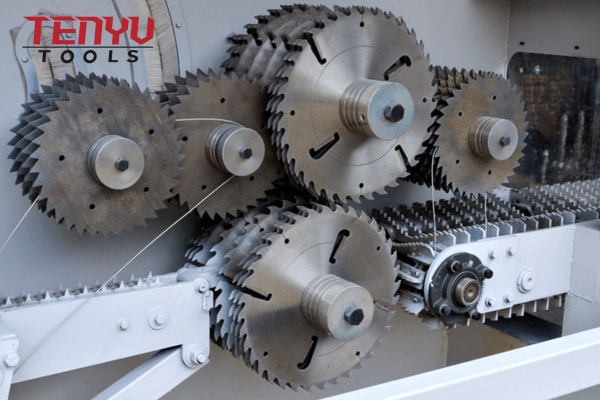
Key Factors in Diameter Selection
Selecting the correct diameter isn’t just about fitting the blade onto the saw. It impacts cutting depth, stability, and overall efficiency. Here’s what I tell clients like Alex Costa when they ask for advice:
- Machine Installation Limits: This is the most basic constraint. Your multi-rip saw machine is designed for a maximum (and sometimes minimum) blade diameter2. Check the machine’s manual. Exceeding the maximum diameter is unsafe and can damage the saw. The arbor size (usually 25.4mm or 1 inch, but can vary) must also match.
- Cutting Material Thickness: The blade diameter directly determines the maximum cutting depth. A larger diameter blade can cut thicker wood. You need a blade large enough to pass through the thickest material you process regularly.
- Wood Type and Hardness: While diameter is mainly about cutting depth, the type of wood (like Fir, Poplar, Pine, Eucalyptus, imported woods, or miscellaneous woods) and its hardness can influence the overall blade choice, including potentially needing a more robust blade body often associated with larger diameters for demanding cuts.
- Machine Configuration (Multiple Blades): Some multi-rip saws are designed to use blades mounted simultaneously above and below the wood, or side-by-side. This clever setup allows the machine to achieve a greater total cutting thickness without needing extremely large (and expensive) diameter blades. It’s a cost-effective way to process thicker stock. If your machine uses this setup, the required diameter for each blade will be smaller than if a single blade were used for the same total thickness.
- Application: The end product (e.g., log processing, keel processing, furniture components) might influence the precision needed, which indirectly relates to blade stability, sometimes favoring certain diameter ranges.
For example, a client processing thick hardwood logs might need a larger diameter blade or a machine configured for top/bottom blades. Another client making furniture parts from thinner pine might use a smaller diameter blade efficiently. As a factory, Tenyu understands these nuances. We often work with buyers like Alex to ensure they get blades perfectly suited for their machines and materials, sometimes customizing them for specific needs.
Conclusion
Selecting the right multi-rip saw blade diameter involves matching the blade to your machine’s limits and the thickness and type of wood you process. Diameters range widely, from 110mm to 550mm.
If you have questions about selecting the right blade, feel free to reach out to us at Tenyu Tools ([email protected] or visit toolsriseon.com). We’re here to help ensure you get top-quality, cost-effective blades for your needs.

